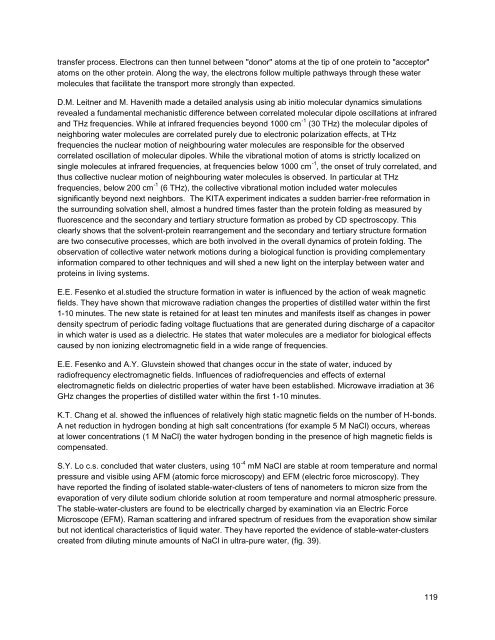a-quantum-model-about-coherence-to-study-non-ionizing-radiation-geesinkresearch-may-2014
a-quantum-model-about-coherence-to-study-non-ionizing-radiation-geesinkresearch-may-2014
a-quantum-model-about-coherence-to-study-non-ionizing-radiation-geesinkresearch-may-2014
Create successful ePaper yourself
Turn your PDF publications into a flip-book with our unique Google optimized e-Paper software.
transfer process. Electrons can then tunnel between "donor" a<strong>to</strong>ms at the tip of one protein <strong>to</strong> "accep<strong>to</strong>r"a<strong>to</strong>ms on the other protein. Along the way, the electrons follow multiple pathways through these watermolecules that facilitate the transport more strongly than expected.D.M. Leitner and M. Havenith made a detailed analysis using ab initio molecular dynamics simulationsrevealed a fundamental mechanistic difference between correlated molecular dipole oscillations at infraredand THz frequencies. While at infrared frequencies beyond 1000 cm -1 (30 THz) the molecular dipoles ofneighboring water molecules are correlated purely due <strong>to</strong> electronic polarization effects, at THzfrequencies the nuclear motion of neighbouring water molecules are responsible for the observedcorrelated oscillation of molecular dipoles. While the vibrational motion of a<strong>to</strong>ms is strictly localized onsingle molecules at infrared frequencies, at frequencies below 1000 cm -1 , the onset of truly correlated, andthus collective nuclear motion of neighbouring water molecules is observed. In particular at THzfrequencies, below 200 cm -1 (6 THz), the collective vibrational motion included water moleculessignificantly beyond next neighbors. The KITA experiment indicates a sudden barrier-free reformation inthe surrounding solvation shell, almost a hundred times faster than the protein folding as measured byfluorescence and the secondary and tertiary structure formation as probed by CD spectroscopy. Thisclearly shows that the solvent-protein rearrangement and the secondary and tertiary structure formationare two consecutive processes, which are both involved in the overall dynamics of protein folding. Theobservation of collective water network motions during a biological function is providing complementaryinformation compared <strong>to</strong> other techniques and will shed a new light on the interplay between water andproteins in living systems.E.E. Fesenko et al.studied the structure formation in water is influenced by the action of weak magneticfields. They have shown that microwave <strong>radiation</strong> changes the properties of distilled water within the first1-10 minutes. The new state is retained for at least ten minutes and manifests itself as changes in powerdensity spectrum of periodic fading voltage fluctuations that are generated during discharge of a capaci<strong>to</strong>rin which water is used as a dielectric. He states that water molecules are a media<strong>to</strong>r for biological effectscaused by <strong>non</strong> <strong>ionizing</strong> electromagnetic field in a wide range of frequencies.E.E. Fesenko and A.Y. Gluvstein showed that changes occur in the state of water, induced byradiofrequency electromagnetic fields. Influences of radiofrequencies and effects of externalelectromagnetic fields on dielectric properties of water have been established. Microwave ir<strong>radiation</strong> at 36GHz changes the properties of distilled water within the first 1-10 minutes.K.T. Chang et al. showed the influences of relatively high static magnetic fields on the number of H-bonds.A net reduction in hydrogen bonding at high salt concentrations (for example 5 M NaCl) occurs, whereasat lower concentrations (1 M NaCl) the water hydrogen bonding in the presence of high magnetic fields iscompensated.S.Y. Lo c.s. concluded that water clusters, using 10 -4 mM NaCl are stable at room temperature and normalpressure and visible using AFM (a<strong>to</strong>mic force microscopy) and EFM (electric force microscopy). Theyhave reported the finding of isolated stable-water-clusters of tens of nanometers <strong>to</strong> micron size from theevaporation of very dilute sodium chloride solution at room temperature and normal atmospheric pressure.The stable-water-clusters are found <strong>to</strong> be electrically charged by examination via an Electric ForceMicroscope (EFM). Raman scattering and infrared spectrum of residues from the evaporation show similarbut not identical characteristics of liquid water. They have reported the evidence of stable-water-clusterscreated from diluting minute amounts of NaCl in ultra-pure water, (fig. 39).119


